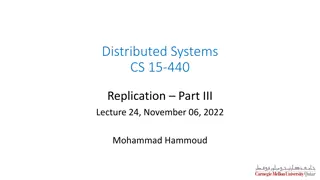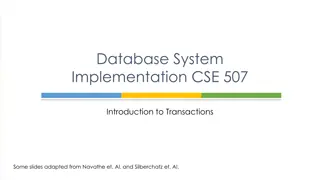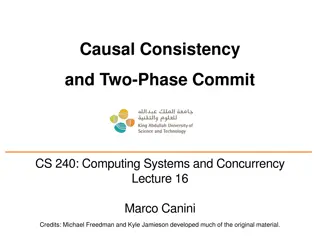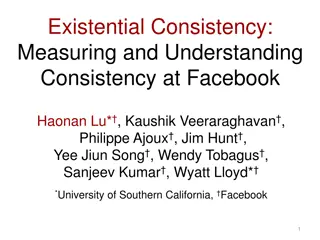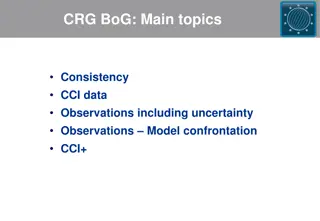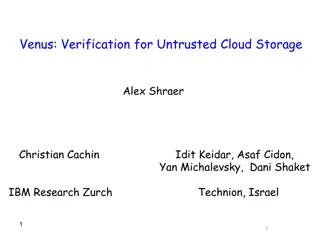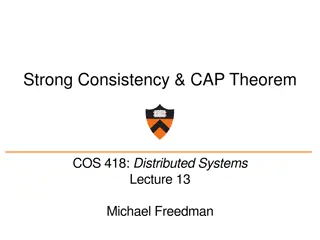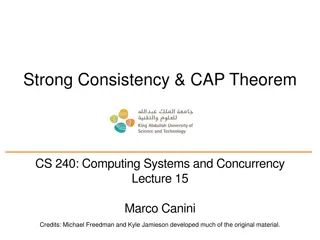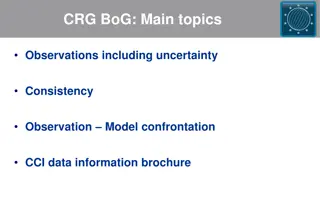
Understanding Data Consistency in Distributed Systems
Learn about strong vs. weak consistency, CAP theorem, linearizability, broken protocols, non-linearizable history, and fixed protocols in distributed systems to grasp the importance of data consistency for system reliability and performance.
Download Presentation

Please find below an Image/Link to download the presentation.
The content on the website is provided AS IS for your information and personal use only. It may not be sold, licensed, or shared on other websites without obtaining consent from the author. If you encounter any issues during the download, it is possible that the publisher has removed the file from their server.
You are allowed to download the files provided on this website for personal or commercial use, subject to the condition that they are used lawfully. All files are the property of their respective owners.
The content on the website is provided AS IS for your information and personal use only. It may not be sold, licensed, or shared on other websites without obtaining consent from the author.
E N D
Presentation Transcript
COS 316 Precept #9 Consistency
Stronger vs Weaker Consistency Strongly Consistent: All nodes in the system see the same data at the same time Characteristics: Synchronization Immediate consistency Weakly Consistent: May take time for all nodes to converge to the latest state, or even not finally converge Characteristics: Asynchronization
Linearizability: Appears to be a single machine Order preserves the real-time ordering between operations If operation A completes before operation B begins, then A is ordered before B in real- time If neither A nor B completes before the other begins, then there is no real-time order (But there must be some total order) Linearizability is a form of strong consistency. Example ETCD: distributed key-value store. Implemented using RAFT.
A broken protocol 1. 2. 3. 4. Client sends operation to replica A A executes operation and returns result to client A sends operation to B and C B and C execute operation and send acknowledgement to A 1 2 3 4 A B 3 4 C
A broken protocol 1 1. 2. 3. 4. Client sends operation to replica B B executes operation and returns result to client B sends operation to C C executes operation and send acknowledgement to B 2 B 3 4 C A
Non-Linearizable History PA w(x=1) PB w(x=2) PC r(x)=1
Fixed Protocol 1. 2. 3. Client sends operation to replica A A sends operation to B and C B and C execute operation and send acknowledgement to A A executes operation and returns result to client 4. 1 4 2 3 A B 2 3 C
Fixed Protocol 1 1. 2. 3. Client sends operation to replica B B sends operation to C C executes operation and sends acknowledgement to B B executes operation and returns result to client 4 B 4. 2 3 C A
Causal+ Consistency 1. Writes that are potentially causally related must be seen by everyone in the same order. 2. Concurrent writes may be seen in a different order by different entities. a. Concurrent: Writes not causally related Example: Node A: write a post (Event 1), then delete that (Event 2) Node B: write another post (Event 3) Causality: (Event 1 -> Event 2) Other nodes may see different order of events, which can be Event 1, Event 2, Event 3 Event 3, Event 1, Event 2 Event 1, Event 3, Event 2 But not Event 2, Event 3, Event 1
Example: D
Eventual consistency If update stops, all the nodes finally reach the latest state Prioritize performance (such as low latency, improved scalability) Example: NoSQL database CDN (Content deliverable networks)


